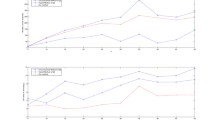Abstract
There are various optimization strategies for approximating, through the minimization of a least-squares loss function, a given symmetric proximity matrix by a sum of matrices each subject to some collection of order constraints on its entries. We extend these approaches to include components in the approximating sum that satisfy what are called the strongly-anti-Robinson (SAR) or circular strongly-anti-Robinson (CSAR) restrictions. A matrix that is SAR or CSAR is representable by a particular graph-theoretic structure, where each matrix entry is reproducible from certain minimum path lengths in the graph. One published proximity matrix is used extensively to illustrate the types of approximation that ensue when the SAR or CSAR constraints are imposed.
Similar content being viewed by others
References
Barthélemy, J.-P., & Guénoche, A. (1991).Trees and proximity representations. Chichester: Wiley.
Carroll, J. D. (1976). Spatial, nonspatial and hybrid models for scaling.Psychometrika, 41, 439–463.
Carroll, J. D., & Pruzansky, S. (1980). Discrete and hybrid scaling models. In E. D. Lantermann & H. Feger (Eds.),Similarity and choice (pp. 108–139). Bern: Huber.
Critchley, F. (1994). On exchangeability-based equivalence relations induced by strongly Robinson and, in particular, by quadripolar Robinson dissimilarity matrices. In B. van Cutsem (Ed.),Classification and dissimilarity analysis (Lecture notes in statistics, pp. 173–199). New York: Springer-Verlag.
Critchley, F., & Fichet, B. (1994). The partial order by inclusion of the principal classes of dissimilarity on a finite set, and some of their basic properties. In B. van Cutsem (Ed.),Classification and dissimilarity analysis (Lecture notes in statistics, pp. 5–65). New York: Springer-Verlag.
Durand, C., & Fichet, B. (1988). One-to-one correspondences in pyramidal representations: A unified approach. In H. H. Bock (Ed.),Classification and related methods of data analysis (pp. 85–90). Amsterdam: North-Holland.
Dykstra, R. L. (1983). An algorithm for restricted least squares regression.Journal of the American Statistical Association, 78, 837–842.
Guttman, L. (1954). A new approach to factor analysis: The radex. In P. F. Lazarsfeld (Ed.),Mathematical thinking in the social sciences (pp. 258–348). Glencoe, IL: The Free Press.
Hubert, L. J., & Arabie, P. (1994). The analysis of proximity matrices through sums of matrices having (anti-)Robinson forms.British Journal of Mathematical and Statistical Psychology,47, 1–40.
Hubert, L. J., & Arabie, P. (1995). Iterative projection strategies for the least-squares fitting of tree structures to proximity data.British Journal of Mathematical and Statistical Psychology, 48, 281–317.
Hubert, L. J., Arabie, P., & Meulman, J. (1997). Linear and circular unidimensional scaling for symmetric proximity matrices.British Journal of Mathematical and Statistical Psychology, 50, 253–284.
Mirkin, B. (1990). A sequential fitting procedure for linear data analysis models.Journal of Classification, 7, 167–195.
Mirkin, B. (1996).Mathematical classification and clustering. Dordrecht: Kluwer.
Robinson, W. S. (1951). A method for chronologically ordering archaeological deposits.American Antiquity, 16, 293–301.
Roux, M. (1988). Techniques of approximation for building two tree structures. In C. Hayashi, E. Diday, M. Jambu, and N. Ohsumi (Eds.),Recent developments in clustering and data analysis (pp. 151–170). New York: Academic Press.
Shepard, R. N., Kilpatric, D. W., & Cunningham, J. P. (1975). The internal representation of numbers.Cognitive Psychology, 7, 82–138.
Author information
Authors and Affiliations
Additional information
The authors are indebted to Boris Mirkin who first noted in a personal communication to one of us (LH, April 22, 1996) that the optimization method for fitting anti-Robinson matrices in Hubert and Arabie (1994) should be extendable to the fitting of strongly anti-Robinson matrices as well.
Rights and permissions
About this article
Cite this article
Hubert, L., Arabie, P. & Meulman, J. Graph-theoretic representations for proximity matrices through strongly-anti-Robinson or circular strongly-anti-Robinson matrices. Psychometrika 63, 341–358 (1998). https://doi.org/10.1007/BF02294859
Received:
Revised:
Issue Date:
DOI: https://doi.org/10.1007/BF02294859




